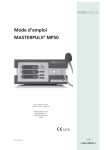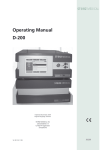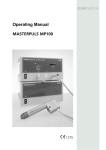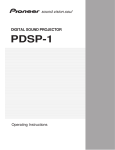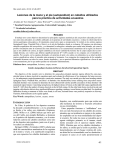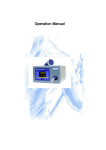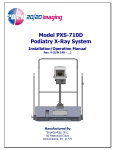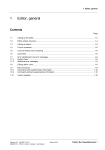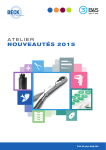Download 6.1 masterpuls mp100 vet
Transcript
Operating Manual MASTERPULS® MP100 VET for veterinary medicine Published October, 2011 Original language: German STORZ MEDICAL AG Lohstampfestr. 8 CH-8274 Tägerwilen Switzerland 20519 »elite edition +« 11 331 02 1011 1-1 blank page 1-2 11 331 02 1011 Table of Contents 1 General Information 1.1 Introduction 1.1.1 Indications . . . . . . . . . . . . . . . . . . 1-5 1.1.2 Contraindications . . . . . . . . . . . . . . . . 1-6 1.1.3 Side effects . . . . . . . . . . . . . . . . . 1-6 1.2 Symbols 1-7 1.3 Prerequisites for operating the MASTERPULS MP100 VET 1-8 1.3.1 Operator . . . . . . . . . . . . . . . . . . . 1-8 1.3.2 Training of the operator 1.4 Description of controls and functional elements 1.4.1 MASTERPULS MP100 VET . . . . . . . . . . . . . . 1-9 1.4.2 Compressed air supply . . . . . . . . . . . . . . 1-10 2 Installation Instructions 2.1 Unpacking 2-3 2.2 Scope of supply 2-3 2.3 Installation 2-4 2.3.1 Handpiece holder installation . . . . . . . . . . . . . 2-4 2.3.2 Connecting the power supply cables . . . . . . . . . . 2-5 2.3.3 Potential equalisation 2.3.4 Handpiece connection . . . . . . . . . . . . . . . 2-6 3 Operation 3.1 General warnings and safety information 3-3 3.2 Start-up 3-7 3.3 Functional checks 3-9 3.4 Standard settings 3-9 3.5 Treatment 3-10 3.6 Info menu 3-12 3.7 Resetting the handpiece shock counter 3-13 4 Cleaning, Maintenance, Overhaul 4.1 Cleaning 4-3 4.2 Fuse replacement 4-4 4.3 Emptying the condensate collector 4-5 4.4 Replacing the filter element 4-6 4.5 Maintenance 4-8 11 331 02 1011 1-3 . . . . . . . . . . . . . . . 1-8 1-9 . . . . . . . . . . . . . . . 2-5 1-3 1-4 4.6 Disposal 4-8 4.7 Repair 4-8 4.8 Service life 4-8 5 Status messages and Trouble-shooting 5.1 Warnings 5-3 5.2 Trouble-shooting 5-5 6 Accessories and Spare Parts 6.1 MASTERPULS MP100 VET 6-3 6.2 Accessories 6-3 6.3 Documentation 6-3 7 Technical Specifications 7.1 MASTERPULS MP100 VET 7-3 7.2 Nameplate 7-4 7.3 Conformity with directives 7-4 7.4 Conformity with standards 7-5 8 Warranty and Service 8.1 Warranty 8.1.1 Warranty for the control device . . . . . . . . . . . . 8-3 8.1.2 Warranty for the handpiece . . 8.2 Service 8-3 . . . . . . . . . . . 8-3 8-3 11 331 02 1011 1 – General information General Information 11 332 02 1011 1 1-1 1 – General information blank page 1-2 11 332 02 1011 1 – General information 1.1 Introduction This manual contains warnings, safety instructions and specific operating instructions in accordance with liability regulations. DANGER ! Refers to a situation of acute danger which, if not avoided, could lead to serious or fatal injury. WARNING ! Refers to a situation of potential danger which, if not avoided, could lead to serious or fatal injury. CAUTION ! Refers to a situation of potential danger which, if not avoided, could lead to minor injury. ATTENTION Warns against possibly harmful situations that could lead to damage to either the product or to the surrounding area. NOTE Additional information concerning specific features or operating instructions is preceded by the term "NOTE". 11 332 02 1011 1-3 1 – General information CAUTION ! Before using the MASTERPULS MP 100 VET for the first time, please ensure that you have read and understood all the information provided in this operating manual. Familiarity with the information and instructions contained in this manual is essential for ensuring efficient and optimal use of the instrument, for avoiding hazards to personnel and equipment and for obtaining good treatment results. Thorough knowledge of the information included in this manual will also enable you to react promptly and effectively in the event of malfunctions and errors. When using optional accessories, please also refer to the separate operating manuals for each of these accessories. It is imperative that users be familiar with the content of this manual before operating any part of this system. The MASTERPULS MP 100 VET is a compressed air-operated ballistic shock wave generator. The shock waves in the MASTERPULS MP 100 VET are generated with a precision ballistic mechanism in the handpiece. A projectile is accelerated by compressed air. The motion and weight of the projectile produces kinetic energy. When the projectile impacts against an immovable surface, the shock transmitter, this kinetic energy is converted into sound energy. This acoustic pulse is transmitted into the tissue to be treated either directly or via an acoustic impedance adapter with the help of a gel. Physically speaking, these are radial pressure waves. The applied pressure pulse propagates radially within the tissue and has a therapeutic effect on areas of the tissue near the surface, in particular. NOTE Medical devices operating on the basis of the above principle are generally referred to as extracorporeal shock wave systems in modern medical literature. 1-4 11 332 02 1011 1 – General information 1.1.1 Indications The MASTERPULS MP100 VET is a compact radial shock wave therapy system. Indications include: For horses –– Insertion desmopathies Suspensory ligament origin Suspensory ligament insertion/sesamoid bones Insertion desmopathy of the cunean tendon Collateral ligaments on various joints Lig. nuchae –– Tendopathy/desmopathies Chronic tendinitis Fibrosis and adhesions Thickening of the annular ligament Desmitis of the suspensory ligaments Calcifications of the tendons or ligaments Metaplasia/myopathies –– Arthroses Pastern joint arthroses Bone spavin Pain therapy for acute arthroses –– Osteoporoses Sesamoid bones Navicular bone –– Pseudarthroses –– Back pain –– Acupuncture Qualified training in acupuncture and acupuncture shock wave therapy (AkuST) is required for therapeutic application of the MASTERPULS MP100 VET in the field of acupuncture. –– Muscle trigger points A sound knowledge of trigger point therapy and trigger point shock wave therapy (TrST) is required for therapeutic application of the MASTERPULS MP100 VET in the field of trigger point shock wave therapy. 11 332 02 1011 1-5 1 – General information For small animals, predominantly dogs –– Fractures/fissures –– Illnesses of tendons and tendon sheaths –– Hip dysplasia –– Osteopathy –– Legg-Calvé-Perthes syndrome –– Degenerative joint diseases –– Chips 1.1.2 Contraindications CAUTION ! The contraindications listed here are examples. No claims are made regarding the completeness or unlimited validity of this list of contraindications. Treatments with the STORZ MEDICAL MASTERPULS MP100 VET are not permitted in the following cases: –– Pregnancy –– Animals in growth –– Cortisone therapy up to 6 weeks before first treatment CAUTION ! Shock waves must not be applied to target areas located above air filled tissue (lungs), nor to any regions near large nerves, vessels, the spinal column or head (except in the facial area). 1.1.3 Side effects Treatment with the MASTERPULS MP100 VET may cause the following side effects: –– Swelling, haematomas –– Petechiae These side effects generally abate after a few days. 1-6 11 332 02 1011 1 – General information 1.2 Symbols Please read the operating manual! Application unit of type B according to IEC 60601 - 1 Potential equalisation R-SW handpiece connector USB connector CSA certification mark WEEE label IPX1: Protection against dripping water (vertically falling drops) Wear hearing protection! 11 332 02 1011 1-7 1 – General information 1.3 Prerequisites for operating the MASTERPULS MP100 VET 1.3.1 Operator The MASTERPULS MP100 VET is intended exclusively for use by veterinary specialists and is only allowed to be used by qualified and instructed personnel. Such a specialist is expected to have practical knowledge of veterinary procedures and applications as well as of the terminology, and should be experienced in treating the indications stated in Chapter 1.1.1 Indications. The specialist must have the basic physical and cognitive prerequisites such as vision, hearing and reading. Furthermore, the basic functions of the upper extremities must be guaranteed. The instrument is designed for a demographic target group between 18 and 65 years. 1.3.2 Training of the operator Operators of the MASTERPULS MP100 VET must have been adequately trained in using this system safely and efficiently before they operate the instrument described in this handbook. An introduction to the principles of operation will be provided by your STORZ MEDICAL dealer with reference to this operating manual and will be documented in the system logbook. The operator must be instructed in the following points: –– Instruction in the operation and designated use of the instrument with practical exercises –– Mechanism of action and function of the instrument and the energies delivered by it –– All component settings –– Indications for use of the instrument –– Contraindications and side effects of the therapy waves –– Explanation of the warning notes in all operating statuses –– Instruction in how to perform the functional checks Further training requirements vary from country to country. It is the operator's responsibility to ensure that the training meets the requirements of all applicable local laws and regulations. Further information on training in the operation of this system is available from your STORZ MEDICAL dealer. However, you can also contact the following address directly: STORZ MEDICAL AG Lohstampfestrasse 8 Postfach CH-8274 Tägerwilen Switzerland 1-8 Telephone: +41 (0) 71 677 45 45 Fax: +41 (0) 71 677 45 05 11 332 02 1011 1 – General information 1.4 Description of controls and functional elements 1.4.1 MASTERPULS MP100 VET 4 5 6 7 8 3 2 9 1 Fig. 1-1  Front view of MASTERPULS MP100 VET 1 Display of selected shock frequency 2 Treatment shock counter 3 Display of selected pressure (nominal value) 4 Shock counter reset button 5 Dial for setting the pressure 6 Operation indicator 7 Handpiece connector 8 Handpiece 9 Buttons for setting the shock frequency 11 332 02 1011 1-9 1 – General information 1 2 3 4 5 6 7 Fig. 1-2  Rear view of MASTERPULS MP100 VET 1 Condensate collector 2 USB connector 3 Filter housing 4 Mains switch 5 Mains fuse holder 6 Mains connector 7 Potential equalisation connector NOTE The USB connector (Fig.1 – 2/2) is only suitable for connecting a USB memory stick that supports USB protocol V1.1. 1.4.2 Compressed air supply The compressed air is supplied by an integrated compressor. 1-10 11 332 02 1011 2 – Installation instructions Installation Instructions 2 11 333 02 0510 2-1 2 – Installation instructions blank page 2-2 11 333 02 0510 2 – Installation instructions 2.1 Unpacking • Remove the instrument and accessories from the packaging container. Proceed with extreme caution. • Check that all items are included in the packaging container and that they are not damaged. • Contact your supplier or the manufacturer immediately if any items are missing or damaged. • Retain the original packaging. It may prove useful for any later equipment transport. 2.2 Scope of supply The standard scope of supply of the STORZ MEDICAL MASTERPULS MP100 VET includes the following items: –– MASTERPULS MP100 VET (control system) –– Mains cable (EU / USA) –– Gel bottle –– User manual (operating manual, system logbook and training records) –– R-SW handpiece set –– Handpiece holder, complete Please refer to Chapter 6 Accessories accessories. 11 333 02 0510 and Spare Parts for information on optional 2-3 2 – Installation instructions 2.3 Installation 2.3.1 Handpiece holder installation • The handpiece can be fitted to the right or to the left side of the instrument as desired by the system user (Fig. 2-1). Fig. 2-1 Location of the bores provided on both side panels • Remove the holders and associated screws from the packaging container. • Mount the handpiece holder as shown in Fig. 2-2. Fig. 2-2 Position of the handpiece holder 2-4 11 333 02 0510 2 – Installation instructions 2.3.2 Connecting the power supply cables • Connect the supplied mains cable to the mains connector (Fig. 2-3/1) on the rear of the instrument. 1 Fig. 2-3 Connecting power supply cables • Insert the mains plug into the socket. Attention When setting up the instrument, make sure that the air outlets on the housing of the MASTERPULS MP100 VET are not blocked. The instrument must only be connected to properly earthed and correctly installed shockproof sockets! 2.3.3 Potential equalisation The MASTERPULS MP100 VET features a potential equalisation connector Fig. 1-2/7). Where necessary, connections for potential equalisation must be made by suitably qualified personnel. CAUTION ! The potential equalisation connector of the MASTERPULS MP100 VET must be connected in accordance with the relevant national regulations. 11 333 02 0510 2-5 2 – Installation instructions 2.3.4 Handpiece connection • Connect the plug of the handpiece to the handpiece connector (Fig. 2-4) of the MASTERPULS MP100 VET. Fig. 2-4 Handpiece connector • Make sure that the red spots on the connector match the red spots on the handpiece connector (Fig. 2-5). Fig. 2-5 Connecting the handpiece • Place the handpiece into the handpiece holder. NOTE Please also refer to the separate operating manual of your handpiece. 2-6 11 333 02 0510 3 – Operation Operation 11 334 02 1011 3 3-1 3 – Operation blank page 3-2 11 334 02 1011 3 – Operation 3.1 General warnings and safety information CAUTION ! The transport bag is provided only to transport the device. If the device is left in the transport bag during treatment, the device becomes hot, due to lack of ventilation. Burns, conflagration and damages of the device are possible. • Take the device out of the transport bag during treatment. ATTENTION Transport the device in the transport bag only when the condensate collector is empty. Otherwise the water can run into the device. 11 334 02 1011 3-3 3 – Operation CAUTION ! The MASTERPULS is exclusively intended for use by medical specialists and must only be used by suitably qualified and trained medical personnel. See also Chapter 1.3 Prerequisites for operating the MASTERPULS MP100 VET. The user is responsible for correctly positioning the handpieces of the MASTERPULS. Correct determination of the location of the treatment zone is the responsibility of the user. Only perform treatments approved by STORZ MEDICAL AG! To avoid safety hazards, use of the instrument for applications other than those specified in Chapter 1.1.1 Indications is not allowed! Do not use the MASTERPULS in potentially explosive environments, i.e. in the presence of a flammable anaesthetic mixture with air or with oxygen or nitrous oxide. The MASTERPULS has a potential equalisation connector. This must be connected in accordance with the relevant national regulations. Cleaning agents and disinfectants can form an explosive atmosphere. Disconnect the MASTERPULS from the mains before starting any cleaning or overhaul work! Do not try to open the instrument! Risk of electric shocks! Disconnect the handpiece from the instrument before carrying out cleaning and maintenance work and do not reconnect it until it has been completely reassembled! Risk of transmission of microorganisms! Clean the handpiece after each use! Refer to Chapter 4.1 Cleaning for details. 3-4 11 334 02 1011 3 – Operation ATTENTION Check that the installation surfaces have sufficient carrying capacity to avoid equipment damage! Electric medical devices underlie special regulations regarding Electromagnetic Compatibility (EMC). Hence, medical electric devices have to be installed and commissioned in accordance with the EMC guidelines detailed in the accompanying documents. Portable and mobile HF communications equipment (such as cell phones) may cause interferences with medical electric devices. The use of accessories or cabling not authorised by the manufacturer may cause increased emissions or may lead to reduced interference resistance of the device. The MASTERPULS is not allowed to be positioned immediately next to or stacked with other devices. If the operation near or jointly with other devices is required, the MASTERPULS has to be tested against that particular environment to ensure operation according to technical specification. The MASTERPULS is allowed to be positioned and operated close to the listed accessories. The instrument must only be connected to properly earthed and correctly installed shockproof sockets! Check that the instrument is in perfect working order before each use, see Chapter 3.3 Functional checks. Never cover the instruments when in use! Make absolutely sure that no liquid can seep into the system housing or handpiece. Any damage to the instrument resulting from incorrect operation is not covered by the manufacturer's warranty. Disposal of the instrument and its components must be carried out in accordance with national waste disposal regulations. The MASTERPULS must only be used with accessories that have been approved by the system manufacturer. For safety reasons, unauthorised system modifications are not permitted. This will void the CE mark approval and warranty. 11 334 02 1011 3-5 3 – Operation NOTE The MASTERPULS MP100 VET corresponds to the requirements of the applicable standards on electromagnetic compatibility (EMC) EN60601-1-2. These limits are designed to provide reasonable protection against harmful interference in a typical medical installation. The instrument described here generates and uses high-frequency energy and can emit the same. If not installed and used in accordance with these instructions, the instrument may cause harmful interference to other devices in the vicinity. However, there is no guarantee that interference will not occur in a particular installation. If this product does cause harmful interference with other devices, which can be determined by turning the instrument off and on, the user is encouraged to try to correct the interference by one or more of the following measures: • Reorient or relocate the receiving device. • Increase the distance between the devices. • Connect the devices into an outlet on a circuit different from that to which the other device is connected. • Consult the manufacturer or field service technician for help. 3-6 11 334 02 1011 3 – Operation 3.2 Start-up NOTE Prior to start-up, please refer to the separate operating manual of your handpiece. • Switch on the MASTERPULS MP100 VET at the mains switch on the rear of the instrument (Fig. 1-2/4). Once the instrument has been started, the display automatically shows the last shock frequency setting. The display flashes. • To confirm the existing setting, press one of the two arrow keys. • To change the existing setting, press one of the two arrow keys. As soon as the display has stopped flashing, the selected shock frequency can be increased or reduced using the arrow keys. With the MASTERPULS MP100 VET, the shock wave frequency can be selected in steps. operating mode energy/frequency R-SW 4 bar/21 Hz R-SW 5 bar/12 Hz V-ACTOR 4 bar/21 Hz V-ACTOR 3 bar/31 Hz • Set the energy of the shocks using the dial (Fig. 3-1/5) to an initial value of 1.5 bar. The value is shown on the pressure display (Fig. 3-1/3). 11 334 02 1011 3-7 3 – Operation 4 5 6 7 8 3 2 9 1 Fig. 3-1 Setting the energy on the control unit 1 Display of selected shock frequency 2 Treatment shock counter 3 Display of selected pressure (nominal value) 4 Shock counter reset button 5 Dial for setting the pressure 6 Operation indicator 7 Handpiece connector 8 Handpiece 9 Buttons for setting the shock frequency The maximum application pressure is limited to 5 bar. To ensure correct system operation, a minimum pressure of 1.0 bar is required. • For working in single shock mode, select the “-” symbol (dash) in the “Frequency” selection box. • To work in continuous shock mode, select a continuous shock frequency in the “Frequency” selection box. operating mode energy/frequency R-SW 4 bar/21 Hz R-SW 5 bar/12 Hz V-ACTOR 4 bar/21 Hz V-ACTOR 3 bar/31 Hz • Activate the trigger button. 3-8 11 334 02 1011 3 – Operation 3.3 Functional checks Perform the following functional checks after the instrument has been installed: • Check the control unit and handpiece for damage. • Take the MASTERPULS MP100 VET into operation (Chapter 3.2 Start-up). • Set the pressure to 1.5 bar. • Reset the treatment shock counter (Fig. 3-1/2) with the reset button (Fig. 3-1/4) on the front of the instrument. • Release individual shocks in single shock mode. • Release shocks in continuous shock mode (shock frequency 1 Hz and 21 Hz). • Check that the triggered shocks are correctly counted on the treatment shock counter on the front of the instrument. • Set the pressure to maximum 4 bar. • Release individual shocks in single shock mode. • Release shocks in continuous shock mode (shock frequency 1 Hz and 21 Hz). • Test the other frequencies as follows: operating mode energy/frequency R-SW 4 bar/21 Hz R-SW 5 bar/12 Hz V-ACTOR 4 bar/21 Hz V-ACTOR 3 bar/31 Hz 3.4 Standard settings • Before each treatment, set the treatment shock counter (Fig. 3 – 1/2) on the control unit to zero by pressing the reset button (Fig. 3-1/4). Treatment should always start at a low energy level. This also applies to resuming treatment after an interruption. • Select a low energy level. 11 334 02 1011 3-9 3 – Operation 3.5 Treatment CAUTION ! The transport bag is provided only to transport the device. If the device is left in the transport bag during treatment, the device becomes hot, due to lack of ventilation. Burns, conflagration and damages of the device are possible. • Take the device out of the transport bag during treatment. ATTENTION Transport the device in the transport bag only when the condensate collector is empty. Otherwise the water can run into the device. CAUTION! Always read Chapter 3.1 General warnings and ty information before beginning treatment. safe- Please also follow the instructions in the separate operating manual for your handpiece. Each time after the instrument has been transported, make sure that all functional checks have been performed on the instrument before you start treatment. Only perform treatments approved by STORZ MEDICAL AG! To avoid safety hazards, use of the instrument for applications other than those specified in Chapter 1.1.1 Indications is not allowed! All status and error messages signaled during treatment must always be attended to without delay! NOTE The maximum energy level used during treatment must not cause the patient undue pain under any circumstances. • Apply a sufficient amount of coupling gel to the patient’s skin in the coupling area and to the shock transmitter. • No more than 300 shocks are allowed to be applied to the same point during treatment. • Avoid excessive pressure of the shock transmitter to the patient‘s skin. Such pressure is not needed for successful treatment. 3-10 11 334 02 1011 3 – Operation CAUTION! The shock transmitter surface will become hot! Extended skin contact can lead to minor burns! • Interrupt treatment after a maximum of 6,000 shocks. CAUTION! The handpiece is not allowed to be operated in idling (without an impact surface). • Do not trigger pulses unless the shock transmitter is in contact with the treatment zone! CAUTION! We recommend that the user wears suitable hearing protection. 11 334 02 1011 3-11 3 – Operation 3.6 Info menu The Info menu enables you to reset the handpiece counter, to call up the total shock count and operating hours of the instrument as well as to read out data about the monitoring software, hardware serial numbers and modification status. • To activate the Info menu, press both arrow keys simultaneously and hold them for two seconds. The display changes to Info mode: The top line (nominal energy display) shows the menu item in question as a number between 1 and 8 (Fig. 3-2/1), whereas the middle line (Fig. 3-2/2) shows the calledup information (in this case: hardware article no.). 1 2 Fig. 3-2 Info mode • Use the two arrow keys to move up or down in the menu in order to call up the following data: Menu item Display 1 Handpiece shock counter 2 Total shock counter 3 Operating hours counter 4 Hardware article no. 5 Hardware change index 6 Not used 7 Software article no. 8 Software change index 9 Bootloader article no. 10 Bootloader change index Table 3-1 Info menu NOTE Shock counter displays 1 and 2 display the shock count in steps of a thousand. • To exit the Info menu, press both arrow keys simultaneously and hold them for two seconds. 3-12 11 334 02 1011 3 – Operation 3.7 Resetting the handpiece shock counter • Switch to Info mode (see Chapter 3.6 Info menu). • Select menu item 1 - Handpiece counter. The number of shocks is displayed in steps of a thousand. The value displayed in the middle line multiplied by 1,000 gives the counter reading for the current handpiece. • Press the reset button to set the handpiece counter to zero.Blank page 11 334 02 1011 3-13 3 – Operation blank page 3-14 11 334 02 1011 4 – Cleaning, maintenance, overhaul Cleaning, Maintenance, Overhaul 11 335 02 0111 4 4-1 4 – Cleaning, maintenance, overhaul blank page 4-2 11 335 02 0111 4 – Cleaning, maintenance, overhaul 4.1 Cleaning Regular cleaning ensures perfect hygiene and operation of the MASTERPULS MP100 VET. CAUTION! Disconnect the instrument from the mains before starting any cleaning or overhaul work! • Wipe the exterior of the housing with a damp cloth. Use soapy water or a mild cleaning agent. Attention It is essential that no fluid be permitted to penetrate either the instrument or its tubing. NOTE For additional information on cleaning and overhauling your handpiece, please refer to the separate operating manual of your handpiece. 11 335 02 0111 4-3 4 – Cleaning, maintenance, overhaul 4.2 Fuse replacement The mains fuse holder is located on the rear of the MASTERPULS MP100 VET. • Push the clip of the mains fuse holder (Fig. 4-1/1) upwards and take the holder off the housing. 1 Fig. 4-1 Mains fuse holder • Pull the old fuses out of the mains fuse holder (Fig. 4-2/1). 1 Fig. 4-2 Fuse replacement • Replace the fuses (T2AL / 250 VAC). • Push the mains fuse holder back into the opening until it engages. 4-4 11 335 02 0111 4 – Cleaning, maintenance, overhaul 4.3 Emptying the condensate collector The condensate collector on the rear of the MASTERPULS MP100 VET should be emptied when three quarters full or earlier. • Remove the condensate collector (Fig. 4-3) from the holder on the rear of the compressor. • Empty the collector and place it back into the holder. Fig. 4-3 Condensate collector 11 335 02 0111 4-5 4 – Cleaning, maintenance, overhaul 4.4 Replacing the filter element If the power output of the compressor integrated in the MASTERPULS MP100 VET starts to decline (severe pressure drop during triggering of shock waves), renew the filter element of the pressure filter. Proceed as follows to change the pressure filter: • Switch off the instrument at the mains switch on the rear and disconnect the mains plug. • Remove the condensate collector. • It is easier to change the filter if you place the MASTERPULS MP100 VET on its head. First, make sure that no condensation has collected in the filter housing. • Remove the pressure filter housing. This can easily be unscrewed by hand (Fig. 4-4). Fig. 4-4 Unscrewing the filter housing After removing the filter housing, it is possible to unscrew the filter element (Fig. 4-5/1) to be renewed. 1 Fig. 4-5 Filter element 4-6 11 335 02 0111 4 – Cleaning, maintenance, overhaul The filter element is secured in the holder using a Philips screw. • First unscrew the fixing screw (Fig. 4-6). • Then remove the complete filter element with the two black air current control rings and the fixing screw. Fig. 4-6 Unscrewing the fixing screw • Take the filter element replacement kit (article no. 18034) and remove the new filter element, that is equipped with new air current control rings and a new fixing screw. 1 2 3 1 Filterelement 2 Befestigungsschraube 3 Strömungsringe Fig. 4-7 Filter element replacement kit • Screw the new filter element into the holder. • Screw the filter housing back onto the holder and tighten it until finger-tight. • Turn the instrument back to its starting position and fasten the condensate collector into the holder provided. • Plug in the mains cable. 11 335 02 0111 4-7 4 – Cleaning, maintenance, overhaul 4.5 Maintenance Preventive maintenance is not necessarily required. However, regular maintenance may help to identify possible defects at an early stage and thus increase the safety and service life of the instrument. Maintenance services can be ordered from our regional representatives in your area or directly from STORZ MEDICAL AG. We recommend that functional and safety checks be performed at least once a year. National accident prevention regulations and test and inspection intervals prescribed for medical devices must, of course, be observed. NOTE For further details on content and performance of the safety checks please contact your local dealer. The following checks should be performed to ensure that the MASTERPULS MP100 VET operates safely. 1 Earth leakage current test in accordance with national regulations. 2 Earth impedance test (with mains cable, incl. applicator housing) according to national regulations. 4.6 Disposal When disposing of the present medical products, no special measures have to be observed. Please proceed in accordance with applicable country-specific regulations. After expiration of its service life, dispose of the MASTERPULS MP100 VET as waste electronic equipment. 4.7 Repair Repair work on defective instruments must only be carried out by personnel suitably authorised by STORZ MEDICAL. Only original STORZ MEDICAL spare parts may be used for this purpose. The personnel suitably authorised can be from STORZ MEDICAL or be representatives of STORZ MEDICAL agencies and dealers. 4.8 Service life The average expected service life is approx. –– 10 years for the MASTERPULS MP100 VET. For information about the service life of your handpiece, please refer to the separate operating manual for your handpiece. Exceeding the service life can be expected to result in a failure of the instrument and accessories. This also applies to handpieces. In this case, no warranty claims shall be accepted on the basis of the information given in Chapter 8 Warranty and Service. 4-8 11 335 02 0111 5 – Status messages and trouble-shooting Status messages and Trouble-shooting 11 336 02 0510 5 5-1 5 – Status messages and trouble-shooting blank page 5-2 11 336 02 0510 5 – Status messages and trouble-shooting 5.1 Warnings The following list gives the most important error codes and the actions that you should take if they occur. Error number Fault description Corrective action Memory error Acknowledge with the reset , continued button operation is possible. Trigger button is pressed during the switch-on procedure Release the trigger button, continued operation is possible. The handpiece is not connected Connect the handpiece, continued operation is possible. Internal fault Acknowledge with the reset , continued button operation is possible. Internal fault Acknowledge with the reset , continued button operation is possible. Internal fault Acknowledge with the reset , continued button operation is possible. Fault 1 Fault 10 Fault 11 Fault 12 Fault 20 Fault 21 11 336 02 0510 5-3 5 – Status messages and trouble-shooting Fault 22 Problem with update on USB stick Acknowledge with the reset , button check update on stick, continued operation is possible. USB stick not inserted Insert USB stick. Problem with update on USB stick Acknowledge with the , check reset button update on stick, continued operation is possible. Problem with update on USB stick Acknowledge with the , check reset button update on stick, continued operation is possible. No current software update Acknowledge with the , check reset button update on stick, continued operation is possible. Fault 23 Fault 24 Fault 25 Fault 26 Table 5-1 Warnings 5-4 11 336 02 0510 5 – Status messages and trouble-shooting 5.2 Trouble-shooting CAUTION ! Unplug the mains cable from the instrument before you carry out any maintenance work! Fault description Possible cause Corrective action Instrument does not work Power failure Check the power supply Defective mains fuse Replace the fuses Defective mains plug Replace the mains cable Leaks on handpiece cable or cable not properly connected Check the cable and tube connections and replace them, if necessary No compressed air supply Clogged compressor air Check the compressor air filter and replace it, if necessary filter No shock wave power output No compressed air supply Call your Service center Blocked or worn projectile Dismantle the handpiece Clean the guide tube and projectile Overhaul the handpiece Malfunction in control unit Call your Service center Handpiece defective Replace the handpiece Table 5-2 Trouble-shooting 11 336 02 0510 5-5 5 – Status messages and trouble-shooting blank page 5-6 11 336 02 0510 6 – Accessories and spare parts Accessories and Spare Parts 11 337 02 1011 6 6-1 6 – Accessories and spare parts blank page 6-2 11 337 02 1011 6 – Accessories and spare parts 6.1 MASTERPULS MP100 VET Mains cables Mains cable CEE 7 Europe, 4 m long 13455 Mains cable CH 3 m long 13448 Mains cable USA 3 m long 16441 NOTE For information on the R-SW handpiece and its accessories please refer to the separate operating manual of the R-SW handpiece. 6.2 Accessories Gel bottles 2 x 250 ml 18189 MASTERPULS MP100 VET equipment trolley 20494 MASTERPULS MP100 VET transport case 17415 Acoustic impedance adapter (50 units) 13470 F-Meter set 15323 V-ACTOR II handpiece set 20212 V-ACTOR II handpiece holder 18825 6.3 Documentation MASTERPULS MP100 VET user manual 11 337 02 1011 20519 6-3 6 – Accessories and spare parts blank page 6-4 11 337 02 1011 6 – Accessories and spare parts Technical Specifications 11 338 02 1011 7 7-1 6 – Accessories and spare parts blank page 7-2 11 338 02 1011 6 – Accessories and spare parts 7.1 MASTERPULS MP100 VET R-SW operating mode single shock, continuous shock 1-21 Hz/4 bar in steps of 0.1 bar continuous shock 1-12 Hz/5 bar in steps of 0.1 bar V-ACTOR operating mode 12 - 31 Hz/3 bar 12 - 21 Hz/4 bar Mains input voltage 100 – 240 VAC Mains frequency Mains fuse Power consumption 50 / 60 Hz T2AL / 250 VAC max. 200 VA Compressed air output 1 – 4 bar Ambient temperature during operation 5 – 40 °C Ambient temperature during storage and transport 0 – 60 °C (frost-free) Ambient air pressure Air humidity Control unit weight Housing dimensions (W x H x D) Protection against the ingress of water 800 – 1060 hPa 5 – 95%, non-condensing 9.9 kg 340 x 165 x 340 mm IPX1 Table 7-1 MASTERPULS MP100 VET technical specifications Subject to technical modifications 11 338 02 1011 7-3 6 – Accessories and spare parts 7.2 Nameplate Fig. 7-1 Nameplate Fig. 7-2 Location of the nameplate 7.3 Conformity with directives This product has been issued with a CE mark in accordance with 84/539/EEC. 7-4 11 338 02 1011 6 – Accessories and spare parts 7.4 Conformity with standards This instrument complies with the applicable standards EN 60601-1, CAN CSA-C22.2 No.601.1, UL Std. No 60601-1. EMC guidelines and manufacturer's declaration Guidelines and manufacturer's declaration – emitted electromagnetic interference The MASTERPULS MP100 VET model is intended for use in the electromagnetic environment specified below. The customer or user of the MASTERPULS MP100 VET should ensure that it is used in such an environment. Emitted interference measurements Compliance Electromagnetic environment - guidelines Group 1 The MASTERPULS MP100 VET uses HF energy exclusively for its internal functioning. Therefore, its HF emissions are very low and are not likely to cause any interference in nearby electronic equipment. HF emissions acc. to CISPR 11 HF emissions acc. to CISPR 11 Class B Harmonic emissions IEC 61000-3-2 Class A Voltage fluctuations / flicker emissions acc. to IEC 61000-3-3 11 338 02 1011 The MASTERPULS MP100 VET is suitable for use in all facilities, including those in residential areas and those that are directly connected to a public electricity supply network that also powers devices which are used for residential purposes. Complies 7-5 6 – Accessories and spare parts Guidelines and manufacturer's declaration – electromagnetic immunity The MASTERPULS MP100 VET model is intended for use in the electromagnetic environment specified below. The customer or user of the MASTERPULS MP100 VET should ensure that it is used in such an environment. Immunity test Compliance level Electromagnetic environment - guidelines Electrostatic discharge (ESD) acc. to IEC 61000-4-2 ± 6 kV contact discharge ± 8 kV air discharge ± 6 kV contact discharge ± 8 kV air discharge Floors should be wood, concrete or ceramic tile. If floors are covered with synthetic material, the relative humidity should be at least 30%. Fast transient electrical interference / bursts according to IEC 61000-4-4 ± 2 kV for power supply lines ± 1 kV for input/ output lines ± 2 kV for power supply lines ± 1 kV for input/ output lines The quality of the supply voltage should be at least that of a typical business or hospital environment. Surge according to IEC 61000-4-5 ± 1 kV line(s) to line(s) ± 2 kV line(s) to earth ± 1 kV line(s) to line(s) ± 2 kV line(s) to earth The quality of the supply voltage should be at least that of a typical business or hospital environment. Voltage drops, short interruptions and voltage variations on power supply input lines IEC 61000-4-11 < 5% UT < 5% UT (> 95% drop in UT) for ½ period (> 95% drop in UT) for ½ period 40% UT 40% UT (60% drop in UT) for 5 periods (60% drop in UT) for 5 periods 70% UT 70% UT The quality of the supply voltage should be at least that of a typical business or hospital environment. It is recommended that the MASTERPULS MP100 VET should be operated with an uninterruptible power supply if the user of the MASTERPULS MP100 VET demands continuing function even if there are interruptions in the power supply. (30% drop in UT) for 25 periods (30% drop in UT) for 25 periods < 5% UT < 5% UT (> 95% drop in UT) for 5 s (> 95% drop in UT) for 5 s Power frequency (50/60 Hz) magnetic field according to IEC 61000-4-8 NOTE 7-6 IEC 60601 test level 3 A/m 3 A/m The mains frequency magnetic fields should be that of a typical business or hospital environment. UT is the mains alternating voltage prior to application of the test level. 11 338 02 1011 6 – Accessories and spare parts Guidelines and manufacturer's declaration – electromagnetic immunity The MASTERPULS MP100 VET model is intended for use in the electromagnetic environment specified below. The customer or user of the MASTERPULS MP100 VET should ensure that it is used in such an environment. IEC 60601 test level Immunity test Compliance level Electromagnetic environment - guidelines Portable and mobile radio equipment should not be used closer to the MASTERPULS MP100 VET, including its cables, than the recommended safety distance that is calculated using the applicable equation for the transmission frequency. Recommended safety distance: Conducted HF interference according to IEC 61000-4-6 3 Vrms 150 kHz to 80 MHz 3 Vrms 150 kHz to 80 MHz Radiated HF interference according to IEC 61000-4-3 3 V/m 80 MHz to 2.5 GHz 3 V/m 80 MHz to 2.5 GHz d = 1.2√P d = 1.2√P for 80 MHz to 800 MHz d = 2.3√P for 800 MHz to 2.5 GHz Where P is the rated power of the transmitter in watts [W] according to the transmitter manufacturer and d is the recommended safety distance in metres [m]. The field intensity of stationary radio transmitters, based on an on-site inspection a, should be less than the compliance level.b Interference may occur in the vicinity of instruments marked with the following symbol. NOTE 1 At 80 MHz and 800 MHz, the higher frequency range applies. NOTE 2 These guidelines may not apply in all situations. Electromagnetic propagation is affected by absorption and reflection from structures, objects and people. a Field strengths from fixed transmitters, such as base stations for radio (cellular/cordless) telephones and land mobile radios, amateur radio, AM and FM radio broadcast and TV broadcast cannot be predicted theoretically with accuracy. To assess the electromagnetic environment due to fixed RF transmitters, an electromagnetic site survey should be considered. If the measured field intensity at the location of the MASTERPULS MP100 VET exceeds the compliance level specified above, the MASTERPULS MP100 VET must be observed at each application location to ensure it is operating normally. If any unusual performance characteristics are observed, it may be necessary to take additional measures such as reorienting or relocating the MASTERPULS MP100 VET. b Over the frequency range 150 kHz to 80 MHz, field strengths should be less than 3 V/m. 11 338 02 1011 7-7 6 – Accessories and spare parts Recommended safety distances between portable and mobile HF communications equipment and the MASTERPULS MP100 VET The MASTERPULS MP100 VET is intended for operation in an electromagnetic environment within which emitted HF interference is monitored. The operator or the user of the MASTERPULS MP100 VET can help to prevent electromagnetic interference by complying with minimum distances between portable and mobile HF communications equipment (transmitters) and the MASTERPULS MP100 VET as recommended below according to the maximum output power of the communications equipment. Safety distance according to frequency of transmitter [m] Rated power of transmitter [W] 150 kHz to 80 MHz d = 1.2√P 80 MHz to 800 MHz d = 1.2√P 800 MHz to 2.5 GHz d = 2.3√P 0.01 0.12 0.12 0.23 0.1 0.38 0.38 0.73 1 1.2 1.2 2.3 10 3.8 3.8 7.3 100 12 12 23 For transmitters rated at a maximum output power not listed above, the recommended safety distance can be estimated using the equation applicable to the frequency of the transmitter, where P is the rated power of the transmitter in watts [W] according to the transmitter manufacturer. NOTE 1 An additional factor of 10/3 was used for calculating the recommended safety distance of transmitters in the frequency range from 80 MHz to 2.5 GHz, in order to reduce the probability that a mobile/portable communications device brought into the patient area inadvertently might lead to a malfunction. NOTE 2 These guidelines may not apply in all situations. Electromagnetic propagation is affected by absorption and reflection from structures, objects and people. 7-8 11 338 02 1011 6 – Accessories and spare parts 11 338 02 1011 7-9 6 – Accessories and spare parts blank page 7-10 11 338 02 1011 8 – Warranty and service Warranty and Service 11 339 02 0111 8 8-1 8 – Warranty and service blank page 8-2 11 339 02 0111 8 – Warranty and service 8.1 Warranty ATTENTION Modifications to the instrument or handpiece are not permitted. Any unauthorised opening, repair or modification of the instrument by unauthorised personnel will relieve the manufacturer of its liability and responsibility for safe system operation. This will automatically void the warranty even before the end of the warranty period. 8.1.1 Warranty for the control device During the two-year warranty period from the date of delivery of the product to the end customer, defects will be remedied at no charge to the customer upon the customer furnishing adequate proof that the defect is due to defects in material or workmanship. The warranty does not extend to wear parts. Transport costs and the risk of loss during the shipping of returned products shall be borne by the customer. Please complete the attached warranty card and return it as soon as possible to the address below: STORZ MEDICAL AG Lohstampfestrasse 8 CH-8274 Tägerwilen Switzerland 8.1.2 Warranty for the handpiece The warranty conditions for the handpiece can be found in the operating manual for the corresponding handpiece. Warranty claims will only be accepted if the handpiece is returned in its complete and original state, cleaned and in the case, with the repair label filled in completely. Missing components will be replaced subject to charge. Accessories also sent will be checked and, if necessary, replaced after we have assessed them. Shock transmitters and overhaul kits are not covered by the handpiece’s warranty. 8.2 Service Should you have any further questions or require additional information, please feel free to contact your dealer. 11 339 02 0111 8-3 8 – Warranty and service blank page 8-4 11 339 02 0111


































































